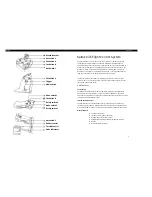
5.4
Alarm relay hysteresis (deadband)
Display:
A
x
HY
Range:
0
to
9999
Default Value:
10
Displays and sets the alarm relay hysteresis limit for the designated relay
x
. Note
x
will be replaced
by the relay number when displayed e.g.
A1HY
for relay 1. To set a relay hysteresis value go to the
A
x
HY
function and use the
^
or
v
push buttons to set the value required then press
F
to accept
this value. The hysteresis value is common to both high and low setpoint values. The hysteresis
value may be used to prevent too frequent operation of the relay when the measured value is rising
and falling around setpoint value. e.g. if
A1HY
is set to zero the alarm will activate when the
display value reaches the alarm setpoint (for high alarm) and will reset when the display value falls
below the setpoint, this can result in repeated on/off switching of the relay at around the setpoint
value.
The hysteresis setting operates as follows: In the high alarm mode, once the alarm is activated
the input must fall below the setpoint value minus the hysteresis value to reset the alarm. e.g. if
A1Hi
is to
50.0
and
A1Hy
is set to
3.0
then the setpoint output relay will activate once the
display value goes to
50.0
or above and will reset when the display value goes below
47.0
i.e. at
46.9
or below. In the low alarm mode, once the alarm is activated the input must rise above the
setpoint value plus the hysteresis value to reset the alarm. e.g. if
A1Lo
is to
20.0
and
A1Hy
is set to
10.0
then the alarm output relay will activate when the display value falls to
20.0
or
below and will reset when the display value goes above
30.0
i.e at
30.1
or above. The hysteresis
units are expressed in displayed engineering units.
Example:
If
A1Hi
is set to
100
and
A1HY
is set to
10
then relay 1 will activate when the
display value is
100
or higher and will reset at a display value of
89
or lower.
5.5
Alarm relay trip time
Display:
A
x
tt
Range:
0
to
9999
Default Value:
0
Displays and sets the alarm trip time in seconds. The trip time is common for both alarm high and
low setpoint values. The trip time provides a time delay before the alarm relay will activate when
an alarm condition is present. The alarm condition must be present continuously for the whole trip
time period before the alarm will activate. If the input moves out of alarm condition during this
period the timer will reset and the full time delay will be restored. This trip time delay is useful
for preventing an alarm trip due to short non critical deviations from setpoint. The trip time is
selectable over
0
to
9999
seconds. To set a trip time value go to the
A
x
tt
function and use the
^
or
v
push buttons to set the value required then press
F
to accept this value.
Example:
If
A1tt
is set to
5
seconds then the display must indicate an alarm value for a full 5
seconds before relay 1 will activate.
RM4AVMAN-2.1-0
17 of
















































